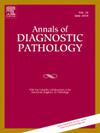Small but significant: Prognostic value of the small duct type in intrahepatic cholangiocarcinoma
IF 1.4
4区 医学
Q3 PATHOLOGY
引用次数: 0
Abstract
This study aimed to evaluate the clinicopathological features, prognostic relevance, and classification accuracy of histological subtypes—the small duct type and the large duct type—in intrahepatic cholangiocarcinoma (iCCA) based on the WHO 5th edition criteria. A retrospective analysis was conducted on iCCA cases classified into the small duct type and the large duct type. Key pathological variables were identified using logistic regression and used to develop a random forest classification model. Survival outcomes were analyzed using Kaplan-Meier and Cox regression analyses. The random forest model, using nine significant pathological features, achieved an overall classification accuracy of 83 %. Mucin production, tumor grade, and intraepithelial lesion were among the most influential predictors. The small duct type was associated with significantly better overall survival (5-year rate: 57.6 %) and recurrence-free survival (46.6 %) compared to the large duct type (24.9 % and 20.6 %, respectively). Multivariable analysis confirmed the large duct type as an independent predictor of worse prognosis. Histological subtyping of iCCA holds important prognostic value. The small duct type is associated with a more favorable clinical course, supporting the integration of subtype-aware assessments into diagnostic and prognostic frameworks. These findings may inform future developments in computational pathology and personalized treatment strategies.

小而重要:小管型在肝内胆管癌中的预后价值
本研究旨在根据WHO第5版标准评估肝内胆管癌(iCCA)的组织学亚型(小管型和大管型)的临床病理特征、预后相关性和分类准确性。回顾性分析小导管型和大导管型iCCA病例。使用逻辑回归识别关键病理变量,并用于建立随机森林分类模型。生存结局采用Kaplan-Meier和Cox回归分析。随机森林模型使用了9个重要的病理特征,总体分类准确率达到83%。粘蛋白产生、肿瘤分级和上皮内病变是影响最大的预测因素。与大导管类型(分别为24.9%和20.6%)相比,小导管类型具有更好的总生存率(5年生存率:57.6%)和无复发生存率(46.6%)。多变量分析证实大导管类型是预后较差的独立预测因子。iCCA的组织学分型具有重要的预后价值。小导管类型与更有利的临床病程相关,支持将亚型意识评估整合到诊断和预后框架中。这些发现可能为计算病理学和个性化治疗策略的未来发展提供信息。
本文章由计算机程序翻译,如有差异,请以英文原文为准。
求助全文
约1分钟内获得全文
求助全文
来源期刊
CiteScore
3.90
自引率
5.00%
发文量
149
审稿时长
26 days
期刊介绍:
A peer-reviewed journal devoted to the publication of articles dealing with traditional morphologic studies using standard diagnostic techniques and stressing clinicopathological correlations and scientific observation of relevance to the daily practice of pathology. Special features include pathologic-radiologic correlations and pathologic-cytologic correlations.

 求助内容:
求助内容: 应助结果提醒方式:
应助结果提醒方式:


